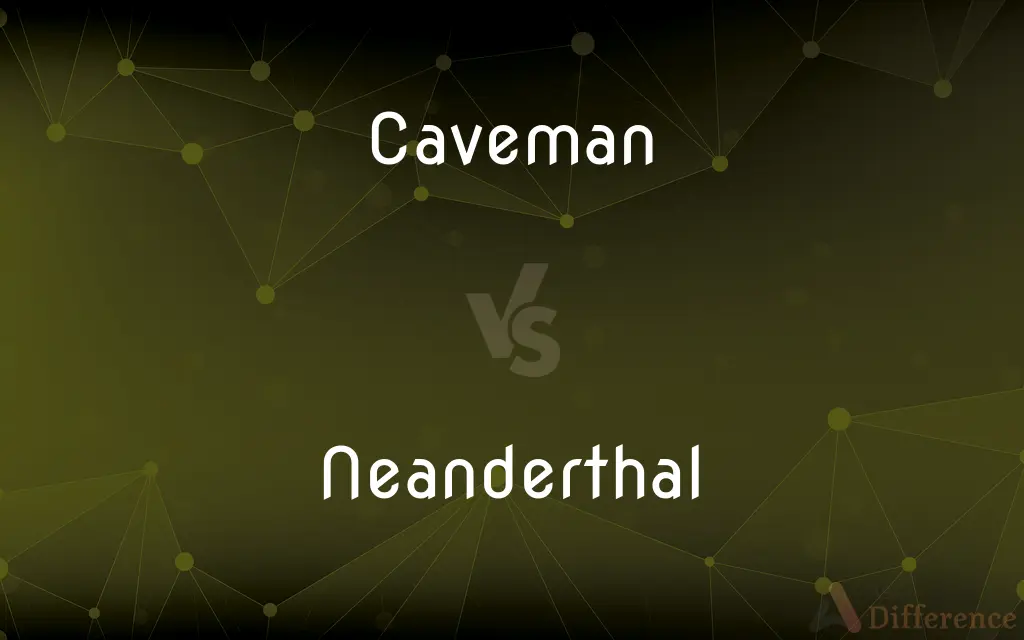Caveman vs. Neanderthal — What's the Difference?
By Maham Liaqat & Urooj Arif — Updated on April 1, 2024
Caveman refers broadly to prehistoric humans known for living in caves, a generic term without specific scientific classification, while Neanderthal denotes a distinct species of the genus Homo, Homo neanderthalensis, closely related to modern humans.

Difference Between Caveman and Neanderthal
Table of Contents
ADVERTISEMENT
Key Differences
Caveman is a colloquial term used to describe early humans or prehistoric people who lived in caves or similar shelters. It is not a scientific term but rather a general descriptor that has been popularized by media and literature to denote a wide range of prehistoric humans, without specificity to any particular period or species. Neanderthals, however, represent a specific group within the human lineage, scientifically classified as Homo neanderthalensis, who lived approximately 400,000 to 40,000 years ago, primarily in Europe and parts of Asia.
The concept of a caveman often conjures images of very primitive, brutish, and unsophisticated people, a stereotype that oversimplifies the diverse and complex cultures of prehistoric humans. This depiction does not accurately reflect the variety of human evolutionary stages or the technological and cultural advancements of these groups. Neanderthals, in contrast, are known through extensive fossil records and archaeological findings that provide a more nuanced understanding of their physical characteristics, culture, and behavior. They created tools, had a diet that included both plants and animals, used fire, and may have had symbolic or ritual practices.
While cavemen are depicted as using basic stone tools, the reality is that prehistoric human technology was quite advanced and varied significantly over time and between different groups. Neanderthals specifically are known for their Mousterian tool culture, which included sophisticated stone tools created using the Levallois technique, a method that allowed for the production of flatter, sharper tools.
In popular culture, cavemen are often shown as isolated, living solely in caves, and having minimal social structure or communication skills. This portrayal ignores the evidence of complex social structures, hunting strategies, and in some cases, elaborate burials among real prehistoric human populations, including Neanderthals. Neanderthals lived in small groups, had complex social bonds, cared for the sick and elderly, and there is evidence to suggest they communicated with each other, possibly using a form of language.
The comparison between cavemen and Neanderthals reflects the difference between a generalized, often fictionalized concept of prehistoric life and a well-researched, scientifically recognized species within human evolution. Neanderthals are a particular branch of humanity's family tree, providing significant insights into the development and spread of early humans, their adaptation to environments, and their eventual disappearance, which is still a subject of research and debate.
ADVERTISEMENT
Comparison Chart
Definition
A general, non-scientific term for prehistoric humans.
A specific species, Homo neanderthalensis, in the human lineage.
Time Period
Broad, unspecified prehistoric era.
Approximately 400,000 to 40,000 years ago.
Location
Various global locations, not specific.
Primarily Europe and parts of Asia.
Culture/Behavior
Stereotypically primitive, with basic tools and social structures.
Evidence of complex tool use, social structures, and possibly symbolic behavior.
Representation
Often depicted in media as unsophisticated and brutish.
Known through archaeological and fossil records, showing a complex reality.
Physical Appearance
Varies widely due to generalization; often depicted as muscular and hairy.
Distinct features include robust builds, prominent brow ridges, and strong limbs.
Technological Advancement
Associated with basic stone tools and fire use.
Known for the Mousterian tool culture and possibly other advanced technologies.
Compare with Definitions
Caveman
Often depicted with rudimentary tools and simple lifestyles.
The typical caveman is shown using a club as a tool and weapon.
Neanderthal
Demonstrated advanced tool-making skills and possibly symbolic behavior.
Neanderthal tools were precisely crafted, showing a high level of skill.
Caveman
Represents a generalized view of early human life.
Popular culture's caveman is more myth than reality.
Neanderthal
A distinct species of the genus Homo, closely related to modern humans.
Neanderthals had a complex culture and sophisticated tools.
Caveman
Broad term for early humans who lived in prehistoric times.
Caveman drawings offer a glimpse into prehistoric life.
Neanderthal
Their extinction is a topic of scientific research and debate.
The reasons behind Neanderthal extinction continue to intrigue scientists.
Caveman
Reflects a stereotyped image rather than a specific historical period.
Caveman stereotypes oversimplify the diversity of prehistoric human cultures.
Neanderthal
Known for specific physical characteristics and living in cold climates.
Neanderthal adaptations to cold environments were remarkable.
Caveman
Associated with living in caves, although not exclusively so.
Cavemen are so named for the shelters they often inhabited.
Neanderthal
Lived in structured social groups, caring for each other.
Evidence suggests Neanderthals cared for their sick and injured.
Caveman
The caveman is a stock character representative of primitive humans in the Paleolithic. The popularization of the type dates to the early 20th century, when Neanderthals were influentially described as "simian" or "ape-like" by Marcellin Boule and Arthur Keith.The term "caveman" has its taxonomic equivalent in the now-obsolete binomial classification of Homo troglodytes (Linnaeus, 1758).
Neanderthal
Neanderthals (, also Neandertals, Homo neanderthalensis or Homo sapiens neanderthalensis) are an extinct species or subspecies of archaic humans who lived in Eurasia until about 40,000 years ago. They most likely went extinct due to assimilation into the modern human genome (bred into extinction), great climatic change, disease, or a combination of these factors.
Caveman
A prehistoric man who lived in caves.
Neanderthal
A species of extinct hominins (Homo neanderthalensis) that lived throughout most of Europe and western and central Asia during the late Pleistocene Epoch until about 30,000 years ago. Members of this species had a large skull and stocky build and are associated with Middle Paleolithic tools.
Caveman
A prehistoric or primitive human living in caves.
Neanderthal
An individual belonging to this species.
Caveman
(Informal) A man who is crude or ill-mannered, especially toward women.
Neanderthal
(Slang) A crude, boorish, or slow-witted person.
Caveman
An early human or closely related species, popularly held to reside in caves.
The political cartoon showed the politician as a caveman, clubbing the budget depicted as a mammoth.
Neanderthal
Also Ne·an·der·tal (-tôl′, -täl′) Of, having to do with, or resembling Neanderthals.
Caveman
A person with backward, primitive behavior, opinions, or interests.
Neanderthal
(Slang) Crude, boorish, or slow-witted.
Caveman
A brutish person, one who behaves in a rough, uncivilized way.
The football squad was made up of cavemen who were responsible for trashing many a locker room.
Neanderthal
Alternative case form of Neanderthal
Caveman
Someone, especially a man, who has regressive, old-fashioned attitudes, particularly with regard to women; someone opposed to change or modernity.
Old Sven is a bit of a caveman; he figures giving women the right to vote was a bad idea.
Pat is a real caveman when it comes to tech, and refuses to get a smartphone.
Neanderthal
Alternative case form of Neanderthal
Caveman
Someone who dwells in a cave
Neanderthal
Uncouth in manners or appearance.
Neanderthal
Of, pertaining to, or named from, the Neanderthal, a valley in the Rhine Province, in which were found parts of a skeleton of an early type of man. The skull is characterized by extreme dolichocephaly, flat, retreating forehead, with closed frontal sutures, and enormous superciliary ridges. The cranial capacity is estimated at about 1,220 cubic centimeters, being about midway between that of the Pithecanthropus and modern man.
Neanderthal
Similar to or reminiscent of a neanderthal human; troglodytic; primitive and uncultured.
Neanderthal
A neanderthal human being; a member of the race Homo sapiens neanderthalensis; as, neanderthals were shorter than modern humans.
Neanderthal
One resembling a neanderthal human; a troglodyte; a cave man.
Neanderthal
A person of primitive, unenlightened or uneducated opinions or attitudes; one with a regressive social or political outlook; - used disparagingly.
Neanderthal
Extinct robust human of Middle Paleolithic in Europe and western Asia
Neanderthal
Ill-mannered and coarse and contemptible in behavior or appearance;
Was boorish and insensitive
The loutish manners of a bully
Her stupid oafish husband
Aristocratic contempt for the swinish multitude
Neanderthal
Relating to or belonging to or resembling Neanderthal man;
Neanderthal skull
Common Curiosities
Can Neanderthals be considered cavemen?
While Neanderthals might fit the broad, popular concept of a "caveman," this term does not accurately capture their specific cultural and biological identity.
Did Neanderthals and early modern humans coexist?
Yes, there is evidence that Neanderthals and early modern humans coexisted and even interbred at certain times and places.
How do we know about Neanderthal culture and behaviors?
Archaeological findings, such as tools, art, and burial sites, provide insights into their complex behaviors and social structures.
Why are cavemen often portrayed inaccurately in media?
Simplified depictions of cavemen serve narrative and entertainment purposes but don't reflect the complexity of prehistoric human life.
What led to the extinction of Neanderthals?
Theories include climate change, competition with modern humans, and interbreeding, leading to assimilation.
Were there any other human species besides Neanderthals during their time?
Yes, besides Neanderthals, other human species like Denisovans and Homo erectus coexisted at various points in prehistory.
What is the significance of cave paintings by early humans?
Cave paintings are thought to be forms of expression, communication, or ritual, reflecting the cognitive and cultural complexity of their creators.
Is it accurate to use "caveman" to describe all early humans?
No, it's an oversimplification. Early human history includes a diverse range of species with different cultures, technologies, and adaptations.
How did Neanderthals adapt to their environment?
Neanderthals adapted through physical traits like a robust build for retaining heat, as well as developing technology and clothing for cold climates.
What did Neanderthals eat?
Neanderthals had a varied diet that included meat from large game, plants, nuts, and possibly fish, indicating they were adaptable omnivores.
How did cavemen communicate?
Early humans likely used a combination of vocal sounds, gestures, and possibly rudimentary forms of language, though specifics vary widely among different groups.
Did Neanderthals have language?
While direct evidence of language is hard to find, the complexity of their social structures and behaviors suggests they may have had some form of advanced communication, possibly including spoken language.
What evidence supports interbreeding between Neanderthals and modern humans?
Genetic studies have found Neanderthal DNA in modern human genomes, particularly among non-African populations, indicating that interbreeding occurred when the two species encountered each other.
What are some misconceptions about Neanderthals?
Common misconceptions include the idea that Neanderthals were significantly less intelligent than modern humans and that they were solely brutish and primitive.
How do modern humans differ from Neanderthals?
Modern humans and Neanderthals share a common ancestor but differ in some physical characteristics, such as skull shape and stature, and possibly in aspects of culture and technology.
Share Your Discovery

Previous Comparison
Recommended vs. Mandatory
Next Comparison
Chock vs. ScotchAuthor Spotlight
Written by
Maham LiaqatCo-written by
Urooj ArifUrooj is a skilled content writer at Ask Difference, known for her exceptional ability to simplify complex topics into engaging and informative content. With a passion for research and a flair for clear, concise writing, she consistently delivers articles that resonate with our diverse audience.














































